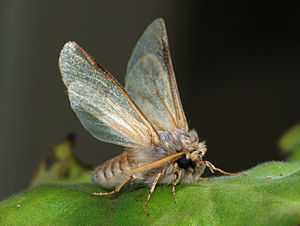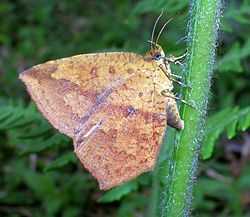Comparison of butterflies and moths
A common classification of the Lepidoptera involves their differentiation into butterflies and moths. Butterflies are a natural monophyletic group, often given the sub-order Rhopalocera, which includes Papilionoidea (true butterflies), Hesperiidae (skippers), and Hedylidae (butterfly moths). In this taxonomic scheme moths belong to the sub-order Heterocera. Other taxonomic schemes have been proposed; the most common putting the butterflies into the sub-order Ditrysia and then the "super-family" Papilionoidea, and ignoring a classification for moths. None of the taxonomic schemes are perfect, however, and taxonomists commonly argue over how to define the obvious differences between butterflies and moths.
Taxonomy
While the butterflies form a monophyletic group, the moths, which comprise the rest of the Lepidoptera, do not. Many attempts have been made to group the superfamilies of the Lepidoptera into natural groups, most of which fail because one of the two groups is not monophyletic: Microlepidotera and Macrolepidoptera, Heterocera and Rhopalocera, Jugatae and Frenatae, Monotrysia and Ditrysia.[1]
Although the rules for distinguishing these groups are not completely hard and fast, one very good guiding principle is that butterflies have thin antennae and (with one exception) have small balls or clubs at the end of their antennae. Moth antennae can be quite varied in appearance, but in particular lack the club end. The divisions are named by this principle: "club-antennae" (Rhopalocera) or "varied-antennae" (Heterocera).
The following families of Lepidoptera are usually considered as butterflies:
- Swallowtails and Birdwings, Papilionidae
- Whites or Yellow-Whites, Pieridae
- Blues and Coppers or Gossamer-Winged Butterflies, Lycaenidae
- Metalmark butterflies, Riodinidae
- Brush-footed butterflies, Nymphalidae which contain the following 13 subfamilies:
- the snout butterflies or Libytheinae (formerly the family Libytheidae).
- the Danaids or Danainae (formerly the family Danaidae).
- the Tellervinae.
- the glasswings or Ithomiinae.
- the Calinaginae.
- the morphos and owls or Morphinae (including the owls as tribe Brassolini).
- the Browns or Satyrinae (formerly the family Satyridae).
- the Charaxinae (preponas and leaf butterflies).
- the Biblidinae.
- the Apaturinae.
- the nymphs or Nymphalinae.
- the Limenitidinae (especially the adelphas) (formerly the family Limenitididae).
- the tropical longwings or Heliconiinae.
The family Hesperiidae, or the Skippers, often considered as butterflies, have significant morphological differences from butterflies and moths.
The other families of the Lepidoptera are considered to be moths.
Morphological differences
Shape and structure of antennae
The most obvious difference is in the feelers, or antennae. Most butterflies have thin slender filamentous antennae which are club-shaped at the end. Moths, on the other hand, often have comb-like or feathery antennae, or filamentous and unclubbed.[2] This distinction is the basis for the earliest taxonomic divisions in the Lepidoptera: the Rhopalocera ("clubbed horn", the butterflies) and the Heterocera ("varied horn", the moths).
There are, however, exceptions to this rule and a few moths (the families Castniidae, Uraniidae, Apoprogonidae, and Sematuridae[3]) have clubbed antennae. Some butterflies, like Pseudopontia paradoxa from the forests of central Africa, lack the club ends. The Hesperiids often have an angle to the tip of the antenna.
Wing-coupling mechanisms
Many moths have a frenulum which is a filament arising from the hindwing and coupling (matching up) with barbs on the forewing. The frenulum can be observed only when a specimen is in hand. Some moths have a lobe on the forewing called a jugum that helps in coupling with the hindwing. Butterflies, however, lack these structures.
Pupae
Most moth caterpillars spin a cocoon made of silk within which they metamorphose into the pupal stage. Most butterfly caterpillars, on the other hand, form an exposed pupa, also termed a chrysalis.
-

Moths typically form a cocoon
-

Butterflies typically form a chrysalis
There are many exceptions to this rule, however. For example, the Hawk moths form an exposed pupa which is underground. Gypsy moths sometimes form butterfly-style pupae, hanging on twigs or tree bark, although usually they create flimsy cocoons out of silk strands and a few leaves, partially exposing the pupa. A few Skipper butterfly larvae also make crude cocoons in which they pupate, exposing the pupa a bit. The Parnassius butterfly larvae make a flimsy cocoon for pupation and they pupate near the ground surface between debris.

Colouration of the wings
Most butterflies have bright colours on their wings. Nocturnal moths on the other hand are usually plain brown, grey, white or black and often with obscuring patterns of zigzags or swirls which help camouflage them from predators as they rest during the day. However, many day-flying moths are brightly coloured, particularly if they are toxic. These diurnal species evolved to locate their mates visually and not primarily by pheromone as their drab nocturnal cousins.[3] A few butterflies are also plain-colored, like the Cabbage White butterfly.
Structure of the body
Moths tend to have stout and hairy or furry-looking bodies, while butterflies have slender and smoother abdomens. Moths have larger scales on their wings which makes them look more dense and fluffy. Butterflies on the other hand possess fine scales. This difference is possibly due to the need for moths to conserve heat during the cooler nights, or to confound echolocation by bats, whereas butterflies are able to absorb sunlight.
Eye types
Despite appearances, butterflies and moths have different types of compound eyes. Though not universal, moths very commonly have superposition eyes, while butterflies equally commonly favor apposition eyes. This is due to the superposition eye's adaptations for low light environments suiting the nocturnal moths, and the apposition eye's superior resolution and potential for color vision benefiting the more diurnal butterflies.[4]
There are several exceptions to this rule, such as with the diurnal Zygaenidae and Sytomidae families of moths, both of which have apposition eyes, or the nocturnal Hedyloidea family of butterflies, which are nocturnal and feature superposition eyes.[5] In most cases where one species is found to be using the opposite type of eye than expected, it is because they are active during the opposite time of day than is normal for other butterflies or moths
Behavioural differences
Time of activity
Most moths are nocturnal or crepuscular while most butterflies are diurnal. There are however exceptions, including the sometimes-diurnal Gypsy moth and the spectacular "Uraniidae" or Sunset moths.
Resting posture
Moths usually rest with their wings spread out to their sides. Butterflies frequently fold their wings above their backs when they are perched although they will occasionally "bask" with their wings spread for short periods. However, some butterflies, like the skippers, may hold their wings either flat, or folded, or even in-between (the so-called "jet plane" position) when perched.
-

Typical moth resting posture
-

Alternative moth resting posture
-
Typical butterfly resting posture
Most moths also occasionally fold their wings above their backs when they are in a certain spot (like when there is no room to fully spread their wings).
A sometimes confusing family can be the "Geometridae" (such as the Winter moth) because the adults often rest with their wings folded vertically. These moths have thin bodies and large wings like many butterflies but may be distinguished easily by structural differences in their antennae (e.g. bipectinate).
Examples of exceptions to the general moth/butterfly distinctions
-
Chrysiridia rhipheus, a day-flying Uraniidae moth, has butterfly-like colours
-

Tetragonus sp., a day-flying Callidulid moth holds its wings like a butterfly but lacks the knobbed antennae
See also
- Lepidoptera
- Papilionoidea
- Hesperioidea
- Caterpillar
References
- ↑ Scoble, MJ 1995. The Lepidoptera: form, function and diversity. Oxford, UK: The Oxford University Press; 404 p.
- ↑ Australian Museum - What are the differences between butterflies and moths? Copyright © Australian Museum - Retrieved June 29, 2010.
- ↑ 3.0 3.1 Scott, James A. (1992). The Butterflies of North America: A Natural History and Field Guide. Calif.: Stanford University Press. p. 94. Retrieved Apr 2011.
- ↑ Greiner, Birgit (16 December 2005). "ADAPTATIONS FOR NOCTURNAL VISION IN INSECT APPOSITION EYES" (PDF). Lund University. Retrieved 11/5/2012. Check date values in:
|accessdate=(help) - ↑ Yack, Jayne; Stephanie E. Johnson; Sarah G. Brown; Eric J. Warrant (14 November 2007). "The eyes of Macrosoma sp. (Lepidoptera: Hedyloidea): a nocturnal butterfly with superposition optics.". Arthropod Structure & Development 36 (1): 11–22. doi:10.1016/j.asd.2006.07.001. PMID 18089084. Check date values in:
|accessdate=(help);
| ||||||||||||||||||||||||||||||||||||||||||||||||||||||||||||||||||||||||||||||||||||||||||||||||||
| ||||||||||||||||

